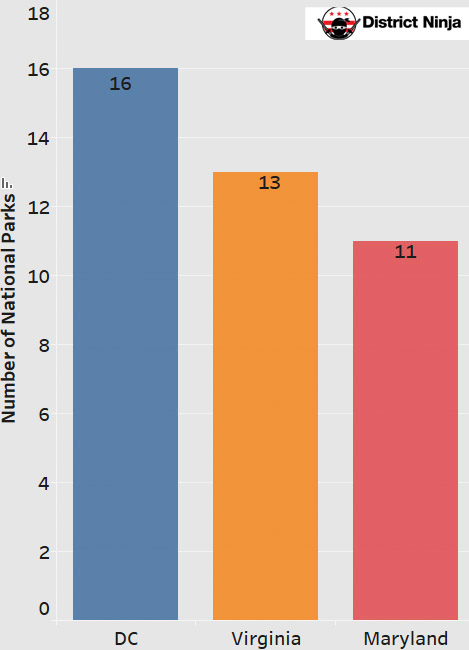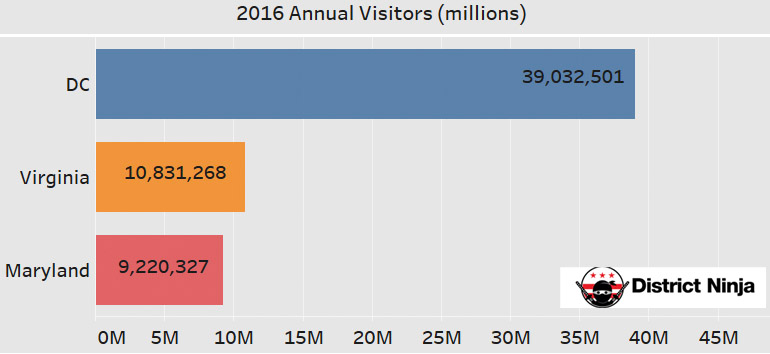Which of our region’s national parks are the most popular?

Image by Craig Fildes licensed under Creative Commons.
The Washington region is home to over 30 national parks, including the sixth most visited national park in the country, the Lincoln Memorial. Here’s how the national parks in our region compare to one another in terms of how many people visit them.
It’s clear that people love our national parks. In 2016, 331 million people visited one or more US National Park Service (NPS) parks across the United States, and the total number of visits in 2017 is already exceeding 2016 rates by almost 8%. All across the country, millions of people are exploring and enjoying the national parks every year.
These were the US national parks with the most visits in 2016:
| Rank | Park | State | Recreational visits |
| 1 | Golden Gate NRA | California | 15,638,777 |
| 2 | Blue Ridge Parkway | North Carolina, Virginia | 15,175,578 |
| 3 | Great Smoky Mountains National Park | North Carolina, Tennessee |
11,312,786 |
| 4 | George Washington Memorial Parkway | Virginia, Washington, DC | 10,323,339 |
| 5 | Gateway NRA | New York/New Jersey | 8,651,770 |
| 6 | Lincoln Memorial | Washington, DC | 7,915,934 |
| 7 | Lake Mead NRA | Arizona/Nevada | 7,175,891 |
| 8 | Grand Canyon National Park | Arizona | 5,969,811 |
| 9 | Natchez Trace Parkway | Alabama, Mississippi, Tennessee | 5,891,315 |
| 10 | Vietnam Veterans Memorial | Washington, DC | 5,299,713 |
| 11 | Independence NHP | Pennsylvania | 5,067,510 |
| 12 | Yosemite NP | California | 5,028,868 |
| 13 | World War II Memorial | Washington, DC | 4,856,532 |
| 14 | Chesapeake & Ohio Canal NHP | Maryland | 4,813,078 |
| 15 | Castle Clinton NM | New York | 4,812,930 |
| 16 | Gulf Islands NS | Florida/Mississippi | 4,771,309 |
| 17 | Cape Cod NS | Massachusetts | 4,692,796 |
| 18 | Rocky Mountains National Park | Colorado | 4,517,585 |
| 19 | Statue of Liberty | New York | 4,501,547 |
| 20 | Franklin Delano Roosevelt Memorial | DC | 4,360,502 |
What’s more, and the Washington Metro Region ranks among the top visited park locations. Washington, DC alone draws more than 39 million visitors to local parks, historic sites, and national monuments annually. The Washington region boasts more than than 38 national park sites, or ⅓ of the top 30 national parks under NPS management.
Even with DC’s considerably smaller size, as compared to Maryland and Virginia, DC contains more national parks than both Virginia and Maryland.
DC also gets, by far, the most visitors to its national parks:
50% of the national park sites in the District saw over a million visitors in 2016. Here’s the full list of DC’s national parks and how many people visited them last year.
While the District contains eight memorials that yielded 1 million+ visitors in 2016, visitor rates are not that equally distributed. The top three memorials (19% of total) accounted for roughly 50% of total 2016 visitors across the District. Even so, the District’s visitor rates are unparalleled, as the total visitors for the Lincoln Memorial alone constituted approximately 85% of the total visitors for all Maryland sites combined.
Maryland may have fewer sites that saw over a million visitors last year, but like DC, it has some sites that people clearly prioritized over others. The C&O Canal National Historic Park, for example, accounted for over 50% of total NPS visitors for the whole state.
Like Maryland, Virginia also had fewer sites that registered over a million visitors. But unlike both DC and Maryland, Virginia had a more equal distribution of overall visitors across its parks.
The future of our nation’s National Park Service sites are at risk. While President Trump may be donating his paycheck to the US National Park Service, the proposed budget released by the White House calls for a 12% cut in funding for the Department of Interior— the agency that keeps the National Park Service running.
This could significantly restrict the Department of the Interior’s ability to acquire and protect new land, as well as further cripple the US National Park Service’s already underfunded mission of managing 530 million acres (or 20%) of US territory.
The proposed budget also calls for the elimination of National Heritage Areas, which leaves current National Historic Parks, such as the C&O Canal (the 14th most visited NPS site nationally), at risk of being eliminated from US National Park Service management.
Want to push back on the current grim outlook? On Saturday, April 22, 2017, celebrate Earth Day at any of the amazing US National Park sites here in the region, and if you fall in love with a place, go to http://campaign.nationalparks.org/ to find out how you can protect the places you love.
Notes on methodology:
- We compiled the list of parks for each state by cross-referencing the official parks listed on the NPS website for each state (example: https://www.nps.gov/state/md/index.htm) and the NPS Annual Report 2016 Visitor Count. We omitted all parks without a visitor rate count.
- Certain parks with visitor rates were omitted that involved “involuntary” attendance rates. For example, the George Washington Parkway is a NPS site that saw over 10,000,000 visitors in 2016. However, people do not generally go visit the GW Parkway the same way they would most NPS sites. Similarly, we left out Wolf Trap in Virginia due to the fact that the main draw is generally the concert/performing act, not the site itself.
- We omitted some parks, such as Harper's Ferry, due to the fact that they fall into more than states outside of what we considered as the Washington region. The official address for Harpers Ferry is in West Virginia.
To see more on how the NPS calculates visitor data, check out https://www.nature.nps.gov/socialscience/stats.cfm.
Correction: The first version of this post said Great Smoky Mountains National Park was in North Carolina and Virginia. It's in North Carolina and Tennessee.





